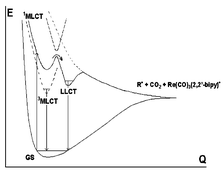Excited state properties of the newly prepared complexes R–CO2–Re(CO)3(2,2′-bipy), where R–CO2−
= naphthalene-2-carboxylate, anthracene-9-carboxylate, pyrene-1-carboxylate and acetate, were investigated by steady state and time resolved spectroscopy. The X-ray structure revealed that the R containing ligand is coordinated through the carboxylate group to Re(I). Results showed that two emitting excited states play a major role in the photophysics of the complexes. The fast component of the complexes luminescence was associated with the charge transfer excited state, MLCT, Re-to-2,2′-bipyridine, while experimental evidence led to the long lived component being attributed to a ligand-to-ligand charge transfer excited state. This emissive LLCT excited state can also evolve to a photodissociative state which ultimately produces the complex decarboxylation. On the other hand, the carboxylate
bridge was shown to be able to impede connection between R and the Re(CO)3(2,2′-bipy) chromophore.
You have access to this article
 Please wait while we load your content...
Something went wrong. Try again?
Please wait while we load your content...
Something went wrong. Try again?


 Please wait while we load your content...
Please wait while we load your content...